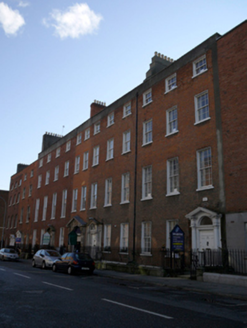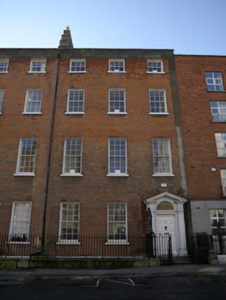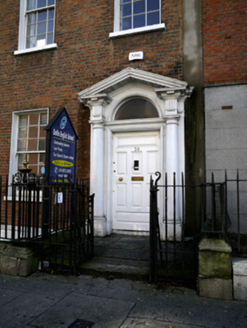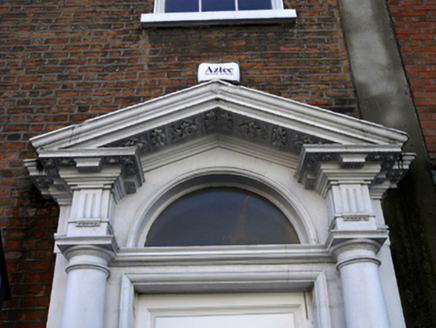Survey Data
Reg No
50010664
Rating
Regional
Categories of Special Interest
Architectural, Artistic
Original Use
House
In Use As
College
Date
1750 - 1770
Coordinates
315409, 234942
Date Recorded
25/10/2011
Date Updated
--/--/--
Description
Terraced three-bay four-storey house over exposed basement, built c.1760, with two-storey return. Now in use as language school. Slate roof, pitched to front pile, with two hipped sections to rear pile, set behind rendered parapet wall with granite coping. Shared cast-iron hopper and downpipe breaking through parapet to north end. Stepped rendered chimneystack with clay pots to north party wall. Red brick walls laid in Flemish bond with flush pointing to painted moulded granite plinth course over ruled-and-lined rendered basement walls. Ruled-and-lined rendered finish to rear elevation walls. Gauged brick flat-arched window openings with patent rendered reveals, painted masonry sills and replacement timber sliding sash windows, six-over-six pane to lower floors and three-over-three pane to top floor, cast-iron grilles to basement windows. Replacement timber sash windows to rear elevation with single round-headed sash window to stairhall. Pedimented painted stone Doric doorcase. Original timber door with eight raised-and-fielded panels, stone architrave surround flanked by engaged Doric columns on plinth blocks supporting full Doric entablature blocks supporting open pediment, accommodating plain glazed fanlight with mutules to entablauture and foliate panels to soffit of pediment. Door opens onto granite platform and single step, bridging the basement. Platform enclosed by wrought-iron railings and wrought-iron corner piers set on moulded granite plinth wall with matching iron gate. Basement area also enclosed by wrought-iron railings on moulded granite plinth wall. Rear of site asphalted and used for car-parking accessed under carriage arch of number 40.
Appraisal
This mid-Georgian townhouse retains original external character and is only one of ten remaining houses on the west end of Lower Dominick Street near Saint Saviour's Church. The house retains a good pedimented doorcase and its overall composition, and couple with the foreground og stone plinth and metal railings, indicates the former grandeur and status of this street within the Georgian core of the city. The land was purchased in 1709 by Christopher Dominick, a physician, and developed by his widow in the 1740s. Previously one of the grandest terraces of Georgian houses in the city, the street fell into dereliction with most houses in tenement use until the 1950s. Slum clearance removed most of the historic character of the street, many of the older buildings being replaced by social housing blocks.







